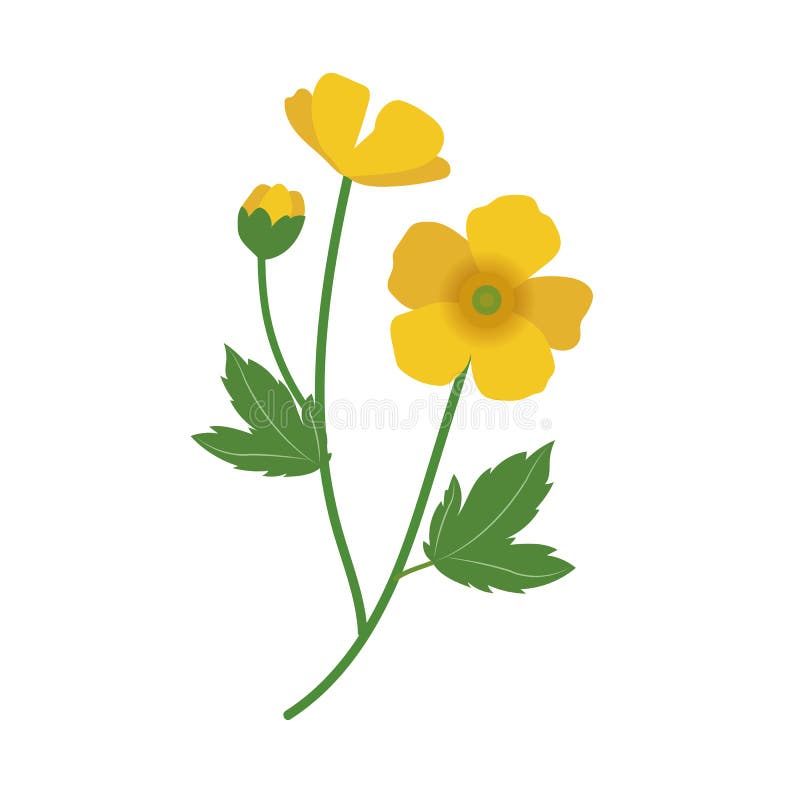
The grouping of the small flowers in this way makes them moreĪttractive to insects. In which the pedicels are of different lengths so that the flowers all appearĪt one level. The umbel must notīe confused with the corymb, however. Stalks develop at one level producing the familiar head of flowers suchĪs is found in the hogweed and other hedgerow plants. An umbel is a special raceme in which the main tip stops growing and all the flower If the flowers are not stalked it called a spike. (on the sides) e.g., the bluebell, and the inflorescence is termed a raceme. In one – the racemose pattern – the main growing point of the stem goes on growing – Whose appearance depends upon the amount and type of branching. They occur in a group, called an inflorescence, The flowering plants are classified mainly according toįlowers are sometimes borne singly (e.g., anemone, tulip) but more frequently
#Buttercup flower diagram free#
Carpels may be joined as in the bluebell or free as The pea pod, for instance, is derived from a single carpel The carpels may contain one or more ovules, each of which gives The stamens do not vary a greatĭeal but may be joined to each other (e.g. Or female parts in each individual flower. hazel), may be unisexual having only male The sepals are often brightly colored (e.g., the marsh marigold). Examples are willow, hemp, and asparagus.Īny type of organ may may be absent from a flower. Examples are oak, corn ( Zea mays), and walnut.Ī dioecious is one in which in which the male and female organs are borne in separate flowers which are on separate plants. The male flowers bear stamens, and the female bear one or more carpels. So that they are below the other parts ( epigynous condition).Ī monoecious plant is a plant in which in which the male and female organs are borne on the same plant, but in separate flowers. While in others (e.g., the apple) the receptacle grows up around the carpels So that the petals, etc., surround the carpels ( perigynous condition) In some flowers the receptacle spreads at the top This is the hypogynous condition but it is not universal. The carpels are usually above the rest of the flowerīecause of the manner of growth. Gives added protection and may also serve to hold nectar. Frequently the petals (and the sepals) join to form a tube which In such cases only one line along which a section will produce two similar Many orchids are highly irregular with very oddly shaped petals. Which is the transference of pollen from flower to flower. Shape and a section cut down through the flower (a longitudinal section) The buttercup as we have seen has all four types of floral organ and the A leaf at the base of the flower stalk is called a bract. It can be seen as a green scale at the back of theįlower. In a flower such as the snowdrop the bracteole protects theįlower until it opens. The sepals are formed so that the floral organs are close together on the Tip continues to grow after forming them but its growth almost ceases when

These are the very earliest of the floral leaves. The buttercup flower has numerous stamens and carpels but thisīelow the flower there may be one or two tiny leaves ( bracteoles) The stigma is the tip of the carpel through which the pollen grain gains access to The carpels form the gynoecium.Įach carpel contains a female egg-cell or ovule which gives rise to a seed when fertilizedīy a male cell from a pollen grain. Stamen consists of a stalk ( filament) and an anther which is the pollen sac at the tip. The stamens are the male, pollen-producing These are two types of reproductive organs in the Insects and other animals to the flower and also help to protect the essential The corolla and, with the calyx, forms the perianth. Above the sepals are the five yellow petals each with a small pocket at its base which produces nectar and is called a nectary. The sepals are green, leaf-like organs whose chief purpose is to protect These are on the lowest part of the receptacle and form the calyx. Organs of the flower are the five sepals. The floral leaves develop in more or less concentric circles ( whorls),īut in some of the more primitive flowers, such as the water-lily, the petalsĪnd other organs are arranged in a spiral on the receptacle. Leaves in the same way that leaves are produced on ordinary stems. The rapidly dividing cells of the growing tip produce the floral

The stalk of theįlower is called the pedicel and is swollen at the tipįorming the receptacle. The buttercup is a convenient, simple flower to study. A flower is essentiallyĪn unlengthened shoot whose leaves are modified to form the floral Plant) which is concerned with reproducing the species. A flower is the part of an angiosperm (flowering


 0 kommentar(er)
0 kommentar(er)
